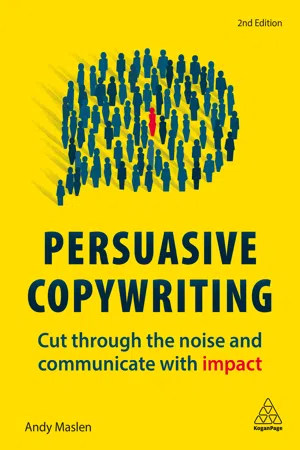
- English
- ePUB (mobile friendly)
- Available on iOS & Android
About this book
Enhance your copywriting skills with psychology-driven techniques to create stand out copy that taps into consumer decision making and sells, using this second edition of the ultimate copywriting survival guide for the 21st century - essential to every marketing or creative professional's bookshelf.
With many professionals now developing their skills on the job, it is notoriously difficult to benchmark successful copy. This book provides a step up for those who already know the basics of writing copy, and are seeking more advanced, psychology-driven techniques to gain the competitive edge. With practical insight into human decision making and consumer engagement, it will inspire the clear-cut confidence needed to create, quantify, and sell stand out copy in a cluttered marketplace.
Complementing the 'how to' perspective of copywriting, with impressive interviews from leading ad agencies and copywriters across the globe, this second edition addresses the everyday issues faced in a multitude of roles, including:
-Practical advice to measure and benchmark effective copy
-Guidance on creating and critiquing briefs
-New chapters on how to weave copywriting skills into the wider industry
-Storytelling and content marketing
-The impact of evolving channels like mobile and social media
Practical, inspiring and extremely digestible, Persuasive Copywriting is the only vibrant, all-encompassing guide to copywriting that you need.
Frequently asked questions
- Essential is ideal for learners and professionals who enjoy exploring a wide range of subjects. Access the Essential Library with 800,000+ trusted titles and best-sellers across business, personal growth, and the humanities. Includes unlimited reading time and Standard Read Aloud voice.
- Complete: Perfect for advanced learners and researchers needing full, unrestricted access. Unlock 1.4M+ books across hundreds of subjects, including academic and specialized titles. The Complete Plan also includes advanced features like Premium Read Aloud and Research Assistant.
Please note we cannot support devices running on iOS 13 and Android 7 or earlier. Learn more about using the app.
Information
PART ONE
Copywriting in a 21st-century context: What now, where next?
01
Creativity
What is creativity?
- Preparation (preparatory work on a problem that focuses the individual’s mind on the problem and explores the problem’s dimensions).
- Incubation (where the problem is internalized into the unconscious mind and nothing appears externally to be happening).
- Intimation (the creative person gets a ‘feeling’ that a solution is on its way).
- Illumination or insight (where the creative idea bursts forth from its preconscious processing into conscious awareness).
- Verification (where the idea is consciously verified, elaborated, and then applied).
Preparation
- We could visit the client’s factory, offices, call centre, trading floor or retail outlets.
- We could spend some time on their social media feeds.
- We could interview a bunch of their customer service people, or their sales team.
- We could spend some time using their product for ourselves. (I am, at the time of writing, still waiting for a call from Maserati.)
Incubation
Intimation
Illumination or insight
Verification
Table of contents
- Cover
- Title Page
- Copyright
- Contents
- List of figures
- List of tables
- Interview with Steve Harrison
- Preface
- Acknowledgements
- How to use this book
- Introduction: How to write like an angel and sell like a demon
- Part One Copywriting in a 21st-century context: What now, where next?
- Part TWO Motivation versus reason: Tapping into your customer’s deepest drives
- Part THREE The pleasure principle: Making your writing more enjoyable and compelling
- Afterword: The XYZ of copywriting
- Glossary
- Further reading
- Workshop
- A note on the type
- Index
- Backcover